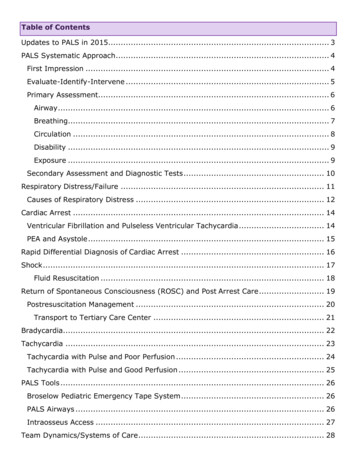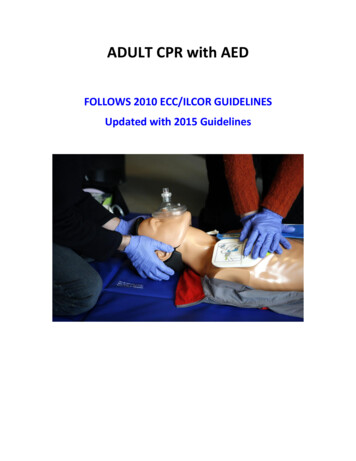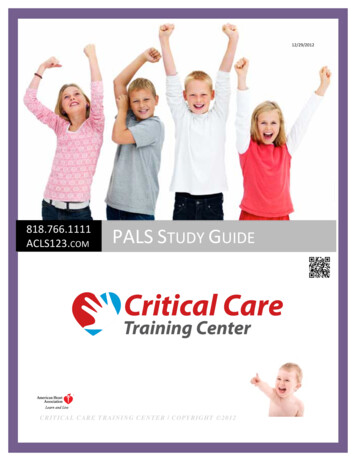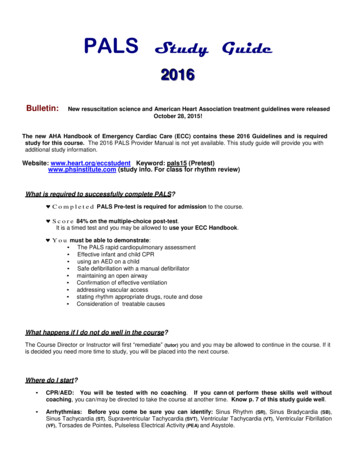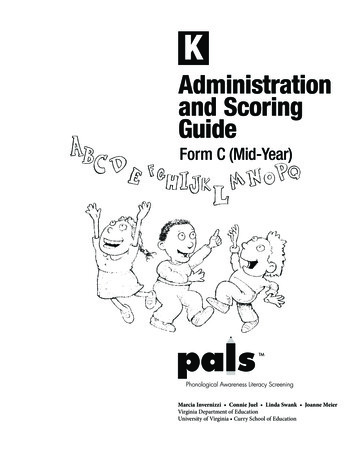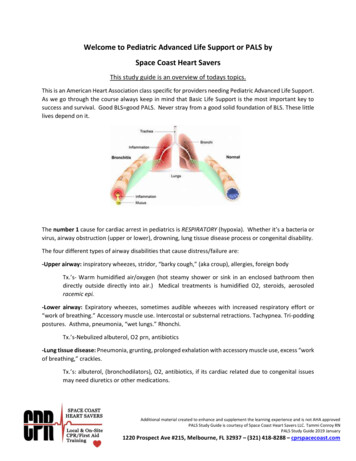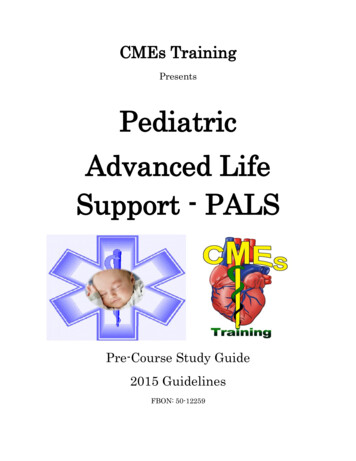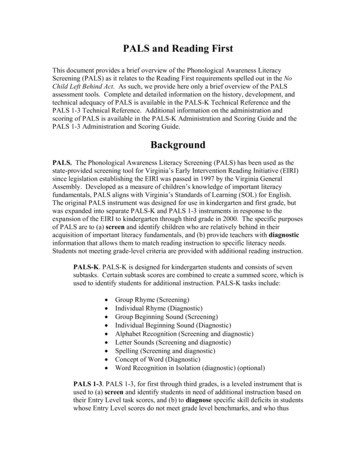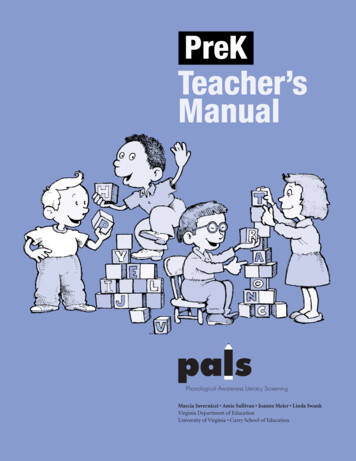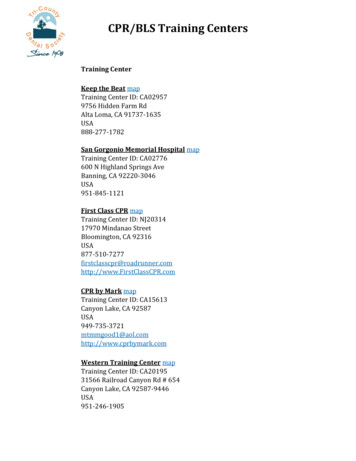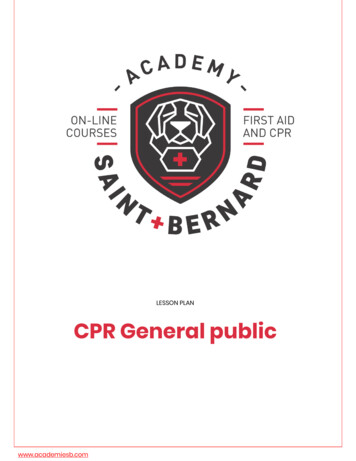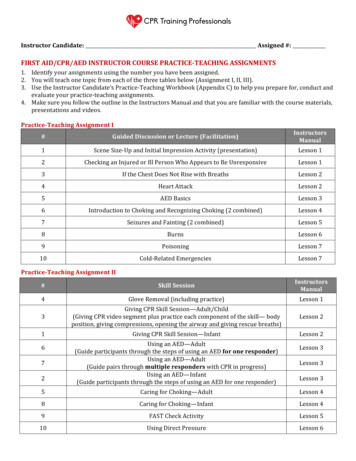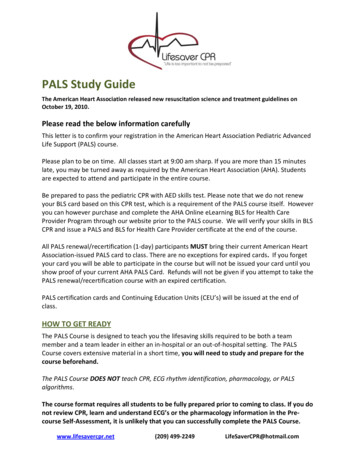
Transcription
PALS Study GuideThe American Heart Association released new resuscitation science and treatment guidelines onOctober 19, 2010.Please read the below information carefullyThis letter is to confirm your registration in the American Heart Association Pediatric AdvancedLife Support (PALS) course.Please plan to be on time. All classes start at 9:00 am sharp. If you are more than 15 minuteslate, you may be turned away as required by the American Heart Association (AHA). Studentsare expected to attend and participate in the entire course.Be prepared to pass the pediatric CPR with AED skills test. Please note that we do not renewyour BLS card based on this CPR test, which is a requirement of the PALS course itself. Howeveryou can however purchase and complete the AHA Online eLearning BLS for Health CareProvider Program through our website prior to the PALS course. We will verify your skills in BLSCPR and issue a PALS and BLS for Health Care Provider certificate at the end of the course.All PALS renewal/recertification (1‐day) participants MUST bring their current American HeartAssociation‐issued PALS card to class. There are no exceptions for expired cards. If you forgetyour card you will be able to participate in the course but will not be issued your card until youshow proof of your current AHA PALS Card. Refunds will not be given if you attempt to take thePALS renewal/recertification course with an expired certification.PALS certification cards and Continuing Education Units (CEU’s) will be issued at the end ofclass.HOW TO GET READYThe PALS Course is designed to teach you the lifesaving skills required to be both a teammember and a team leader in either an in‐hospital or an out‐of‐hospital setting. The PALSCourse covers extensive material in a short time, you will need to study and prepare for thecourse beforehand.The PALS Course DOES NOT teach CPR, ECG rhythm identification, pharmacology, or PALSalgorithms.The course format requires all students to be fully prepared prior to coming to class. If you donot review CPR, learn and understand ECG’s or the pharmacology information in the Pre‐course Self‐Assessment, it is unlikely that you can successfully complete the PALS Course.www.lifesavercpr.net(209) 499‐2249LifeSaverCPR@hotmail.com
PRE‐COURSE REQUIREMENTSYou should prepare for the course by doing the following:1. Complete the pre‐course preparation checklist that came with your PALS ProviderManual. (ALL STUDENTS MUST HAVE THE CURRENT AHA PALS MANUAL PRIOR TOATTENDING CLASS) Bring the checklist with you to the course.2. Review the PALS Course Agenda.3. Review and understand the information in your PALS Provider Manual.4. The resuscitation scenarios require that your BLS skills and knowledge are current.Review and understand all BLS 2010 guidelines. You will be tested on pediatric CPR andAED skills at the beginning of the PALS Provider Course. You must know this in advance,since you will not be taught how to do CPR or how to use an AED during the course.5. Go to the AHA PALS Website at www.heart.org/eccstudent and enter the codePALSPROVIDER. (students are expected to know how to perform BLS CPR, use an AED,read and interpret ECG’s, and all PALS Pharmacology prior to the course. YOU WILL NOTBE TAUGHT THIS INFORMATION IN CLASS)6. Print your PALS Pre‐course Completion Certificate with test score and bring it with youto class.7. Test your knowledge and recognition of ECG rhythms on the websitehttp://www.skillstat.com/ECG Sim demo.html8. Visit my download page at www.lifesavercpr.net/downloads to see all of the PALSCourse Material and Skills Check Off Sheets used during the course.WHAT TO BRING AND WHAT TO WEARBring your PALS Provider Manual to the class. You will need it during each lesson in the course.You may wish to purchase the AHA’s 2010 Handbook of Emergency Cardiovascular Care forHealthcare Providers (optional), which you may bring to the course to use as a reference guideduring some of the stations in the course.Please wear loose, comfortable clothing to class. You will be practicing skills that require you towork on your hands and knees, and the course requires bending, standing, and lifting. If youhave any physical condition that might prevent you from engaging in these activities, please tellan instructor. The instructor may be able to adjust the equipment if you have back, knee, or hipproblems.www.lifesavercpr.net(209) 499‐2249LifeSaverCPR@hotmail.com
RESCHEDULE POLICY No refunds will be issued. All registrations are final. You may reschedule your course by calling us at least 7 business days prior to your scheduledcourse date. You will be charged a rescheduling fee of 50.00 We understand that emergencies do come up. If you have to cancel less than 7 days beforethe class you will be charged a rescheduling fee of 50% of the course cost. If you cancel within 24 hours or do not attend your scheduled class, you will forfeit all classtuition. Courses must be rescheduled and attended within 40 days from the original start date. Noadditional rescheduling requests will be honored.REQUIREMENTS FOR SUCCSESSFUL COMPLETION OF PALS COURSE:Required Tests and Skill Check Off Sheets Completed PALS Pre‐test is required for admission to the course. Successfully complete the Pediatric CPR and AED Skills Check Off Test Sheet Successfully complete the Respiratory Core Case Skills Check Off Test Sheet Successfully complete the Shock Core Case Skills Check Off Test Sheet Successfully complete the Cardiac Core Case Skills Check Off Test Sheet Score 84% or better on the multiple choice PALS posttest.You may be allowed to use your PALS Provider Manual & notes.Skills to be performed:1. Use the PALS rapid cardiopulmonary assessment2. Demonstrate effective infant and child CPR3. Use an AED on a child4. Provide safe defibrillation with a manual defibrillator5. Maintain an open airway6. Confirmation effective ventilation7. Address vascular access8. State rhythm appropriate drugs, route, and dose9. Understand the consideration of reversible causeswww.lifesavercpr.net(209) 499‐2249LifeSaverCPR@hotmail.com
You will need to know:1. Pediatric CPR and AED (foundation for PALS)2. Arrhythmias (identify):a. Sinus Rhythm (SR)b. Sinus Bradycardia (SB)c. Sinus Tachycardia (ST)d. Supraventricular Tachycardia (SVT)e. Ventricular Tachycardia (VT)f. Ventricular Fibrillation (VF)g. Pulseless Electrical Activity (PEA)h. Asystole3. Normal Respiratory Rate (PALS Provider Manual p. 13)AgeRateInfant30 to 60Toddler24 to 40Preschooler22 to 34School‐aged child18 to 30Adolescent12 to 164. Normal Heart Rate (HR) (PALS Provider Manual p. 18)AGEAwake RateSleeping RateNewborn to 3 months85 to 20580 to 1603 months to 2 years100 to 19075 to 1602 to 10 years60 to 14060 to 90More than 10 years60 to 10050 to 905. Hypotension by Systolic Blood Pressure (SBP) (PALS Provider Manual p. 74)AGESystolic Blood PressureTerm Neonates (0 to 28 days)Less than 60Infants (1 to 12 months)Less than 70thChildren 1 to 10 years (5 BP percentile) Less than 70 (age in years X 2)Children less than 10 yearsLess than 90www.lifesavercpr.net(209) 499‐2249LifeSaverCPR@hotmail.com
6. Modified Glasgow Coma ScaleACTCHILDEYE OPENINGSpontaneousTo SpeechTo PainNoneVerbal Response Orientated, AppropriateConfusedInappropriate wordsIncomprehensible soundsNoneMotor Response Obeys CommandsLocalizes painful stimulusINFANTSpontaneousTo SpeechTo PainNoneCoos and BabblesIrritable, CriesCries in response to painMoans in response to painNoneMoves SpontaneouslyWithdraws in response totouchWithdraws in response to Withdraws in response topainpainFlexion in response to Abnormal flexion posturepainto painExtension in response to Abnormalextensionpainposture to painNoneNonewww.lifesavercpr.net(209) .com
HELPFUL STUDENT INFORMATION:RAPID CARDIOPULMONARY ASSESSMENT AND ALGORITHMS This is a systematic head‐to‐toe assessment used to identify pediatric patients in cardiacand respiratory distress and failure, shock, and pulseless arrest. Algorithms are “menus” that guide you through recommended treatment interventions. Know the following assessment because it begins all PALS case scenarios. Theinformation you gather during the assessment will determine which algorithm youchoose for the patient’s treatment.After each intervention you will reassess the patient again using the head‐to‐toe assessment.General Appearance:1. Level of consciousness:a. A awakeb. V responds to verbalc. P responds to paind. U unresponsive2. Skin Tone:a. Warm, pink, and dry to cool, pale/cyanotic, diaphoretic3. Muscle tone:a. Good to flaccidAssess ABC’s:(Stop and give immediate support when needed, and then continue with assessment)1. Airwaya. Open and hold with head tilt‐chin lift2. Breathinga. Present or absentb. Rate normal, slow, fastc. Pattern regular, irregular, gaspingd. Depth normal, shallow, deepe. Sound stridor, grunting, wheezingf. Exertion nasal flaring, sternal retractions, accessory muscle use3. Circulationa. Central pulse present or absentb. Rate normal, slow, fastc. Rhythm regular or irregulard. QRS narrow or widewww.lifesavercpr.net(209) 499‐2249LifeSaverCPR@hotmail.com
Perfusion:1. Central pulse versus peripheral pulse strength: equal or unequal2. Skin color, pattern and temperature: normal or abnormal3. Capillary refill: normal or abnormal (greater than 2 seconds)4. Liver edge palpated at the costal margin: normal or drya. below costal margin (fluid overload)Check:1. Systolic Blood Pressure (normal or compensated): acceptable for age or hypotensive2. Urine output: normal a. Infants and Children 1– 2cc/kg/hr.b. Adolescents 30cc/hr.Classify the physiologic status:1. Stable: needs little support; reassess frequently2. Unstable: needs immediate support and intervention3. Respiratory distress: increased rate, effort and noise of breathing; requires much energy4. Respiratory failure: slow or absent rate, weak or no effort and is very quietSHOCK:1. Compensated shock:a. SBP is acceptable but perfusion is poor: central vs. peripheral pulse strength isunequal; peripheral color is poor and skin is cool, capillary refill is prolonged2. Decompensated shock:a. Systolic hypotension with poor or absent pulses, poor color, weak compensatoryeffort3. Apply Appropriate Shock Treatment Algorithm:a. Bradycardia with a Pulseb. Tachycardia with Adequate Perfusionc. Tachycardia with Poor Perfusiond. Pulseless Arrest: VF/VTe. Asystole/PEAwww.lifesavercpr.net(209) 499‐2249LifeSaverCPR@hotmail.com
ADVANCED AIRWAYA cuffed or uncuffed Endotracheal Tube (ET) may be used on Infants and children.(PALS Provider Manual p. 87)1. To estimate tube size:a. Uncuffed: (Age in years 4) 4 Example: (4 years 4) 1 4 5b. Cuffed: (Age in years 4) 3 Example: (4 years 4) 1 3 4Immediately confirm tube placement by clinical assessment and a device: Clinical assessment:1. Look for bilateral chest rise.2. Look for water vapor in the tube (this is helpful but not definitive).3. Listen for breath sounds over stomach and the 4 lung fields (left and right anterior andmid‐axillary). Devices:1. End‐Tidal CO2 Detector (ETD): if weight 2 kga. Attach between the ETT and BVMi. Litmus paper center should change color with each inhalation and eachexhalation.ii. Original color on inhalation O2 is being inhaled: expected.iii. Color change on exhalation Tube is in trachea.iv. Original color on exhalation Litmus paper is wet: replace ETD.2. Esophageal Detector (EDD): if weight 20 kg and in a perfusing rhythm (Resemblesturkey baster)a. Compress the bulb and attach to end of ETT:i. Bulb inflates quickly Tube is in the trachea.ii. Bulb inflates poorly Tube is in the esophagus.* No recommendation for its use in cardiac arrest. Device Failure:1. When sudden deterioration of an intubated patient occurs, immediately check:b. Displaced: ET tube is not in trachea or has moved into a bronchus (right mainstem most common)c. Obstruction: Consider secretions or kinking of the tubed. Pneumothorax: Consider chest trauma, barotrauma, or non‐compliant lungdiseasee. Equipment: Check oxygen source, BVM, and ventilatorwww.lifesavercpr.net(209) 499‐2249LifeSaverCPR@hotmail.com
MEDICATIONSDuring Arrest:1. Epinephrine: catecholaminea. Increases heart rate, peripheral vascular resistance and cardiac output;during CPR increases myocardial and cerebral blood flow.b. Dosage:i. IV/IO: 0.01 mg/kg of 1:10 000 solution (equals 0.1 mL/kg of the1:10 000 solution); repeat q. 3–5 minAntiarrhythmic:1. Amiodarone: atrial and ventricular antiarrhythmica. Slows AV nodal and ventricular conduction, increases the QT interval and maycause vasodilation.b. Dosage:i. VF/PVT: IV/IO: 5 mg/kg bolusii. Perfusing VT: IV/IO: 5 mg/kg over 20‐60 miniii. Perfusing SVT: IV/IO: 5 mg/kg over 20‐60 miniv. Max: 15 mg/kg per 24 hoursCaution: hypotension, Torsade; half‐life is up to 40 days2. Lidocaine: ventricular antiarrhythmic to consider when Amiodarone is unavailablea. Decreases ventricular automaticity, conduction and repolarization.b. Dosage:i. VF/PVT: IV/IO: 1 mg/kg bolus q. 5‐15 minii. Perfusing VT: IV/IO: 1 mg/kg bolus q. 5‐15 miniii. Infusion: 20‐50 mcg/kg/minc. Caution: neurological toxicity seizures3. Magnesium: ventricular antiarrhythmic for Torsade and hypomagnesemiaa. Dosage:i. IV/IO: 25‐50 mg/kg over 10–20 min; give faster in Torsadeii. Max: 2 gmb. Caution: hypotension, bradycardia4. Procainamide: atrial and ventricular antiarrhythmic to consider for perfusing rhythmsa. Dosage:i. Perfusing recurrent VT: IV/IO: 15 mg/kg infused over 30–60 minii. Recurrent SVT: IV/IO: 15 mg/kg infused over 30–60 minb. Caution: hypotension; use it with extreme caution with Amiodarone as it cancause AV blockwww.lifesavercpr.net(209) 499‐2249LifeSaverCPR@hotmail.com
Increase Heart Rate:1. Epinephrine: Drug of choice for pediatric bradycardia after oxygen and ventilationa. Dose is the same as listed above.2. Atropine: Vagolyt
PALS renewal/recertification course with an expired certification. PALS certification cards and Continuing Education Units (CEU’s) will be issued at the end of class. HOW TO GET READY The PALS Course is designed to teach you the lifesaving skills required to be both a team
